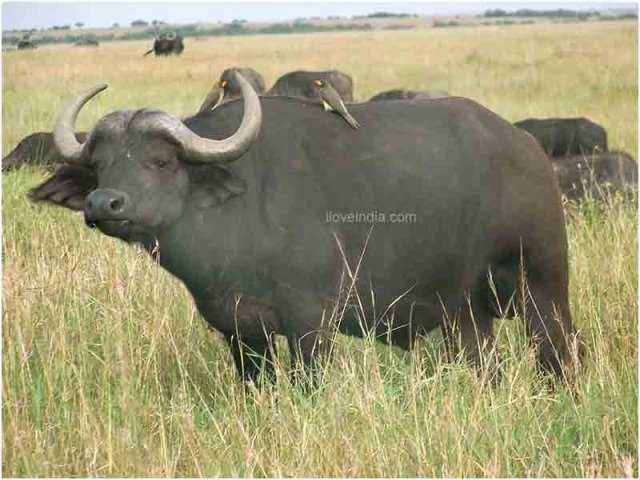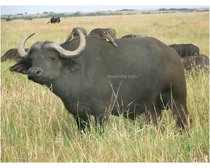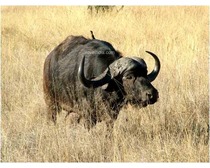African buffaloes are widely found in the forests and savannahs of Africa. In this article, we bring for you some interesting facts and amazing information on the African buffalo.
Facts About African Buffalo
African Buffaloes, also called Affalo or Cape Buffaloes, are large African bovid that inhabit the forests, woodlands and savannahs of Africa. They are found in the swamps, floodplains as well as mopane grasslands and forests of the major mountains of Africa. They prefer the habitat that has a dense cover of reeds and thickets. African Buffaloes depend on large quantities of water and hence, stay close to the perennial sources of the same. They can be described as large cow-like animals, whose body is covered with sparse covering of dark brown hair. Their body features consist of a large head, thick neck, a broad chest and strong legs. These buffaloes have large droopy ears and low curved horns. In case of males, the horns are joined by a boss, which is a shield that covers their entire forehead. Read on to know some more interesting facts and amazing information on the African buffaloes.

Facts About African Buffalo
Binomial Name: Syncerus caffer
Kingdom: Animalia
Phylum: Chordata
Subphylum: Vertebrata
Class: Mammalia
Order: Artiodactyla
Family: Bovidae
Subfamily: Bovinae
Genus: Syncerus
Species: S.caffer
Height: About 1.0-1.7 m (3.3-5.6 ft.), at shoulder
Length: About 2.1-3.4 m (7-11ft.)
Weight: Approximately 425-900 kg (935-2000 lb)
Life Span: 15-25 years
Diet: Herbivorous (feeds on tall and coarse grasses)
Range: Eastern and Southern Africa.
Habitat: Open savannas and grasslands, near a permanent source of water
Age of Sexual Maturity: 3.5 to 5.0 years
Gestation Period: 11.5 months (approximately)
Number of Offspring: One
Interesting & Amazing Information About African Buffalo
- African buffaloes live in groups of large numbers, which often go as high as 2000 members. Members of the same subgroup stay together and sleep by resting their heads on one another.
- The horns of an African buffalo are wonderful indicators of its age and gender. A large adult male has a hard shielding, which protects the base of its skull. This is absent in case of females and young male buffaloes.
- These buffaloes always stay at close proximity of a water source. Particularly in the dry season, when they feed on the dried grasses, they take care to stay close to water.
- Though African buffaloes share a number of similarities with the Asian water buffaloes, they belong to an entirely different species.
- Like Zebras, these buffaloes feed on tall, coarse grasses. While eating, they make use of their tongue and wide incisor row, to feed on the grass quickly.
- African buffaloes are highly dangerous and are more likely to attack when injured or cornered.
- These buffaloes are well-equipped with self defense mechanisms. Other than humans, they have very few predators, like lion, leopard and spotted hyena. However, even the mighty lions need to group up, to bring down a single buffalo.
- African buffaloes fight together against a common predator. They always stay together in a herd, making it difficult for the predator to choose one member out of the group.
- These buffaloes mate strictly during the rainy season. Their reproductive period starts from the age of five years.
- New born calves remain hidden in vegetation for the first few weeks, before joining the main herd. During this time, their mothers nurse them.
- The bond between the mother and child continues for a year or two. The male calves usually leave their mother when they are two years old and join the bachelor group.
- African buffaloes have lots of hair on their body. The adult buffaloes lose hair as they age.
- Diseases like bovine tuberculosis are a great threat to the African buffaloes. However, the national parks of Africa are taking precautionary measures to protect these buffaloes from this disease.


See also
More from iloveindia.com
- Home Remedies | Ayurveda | Vastu | Yoga | Feng Shui | Tattoos | Fitness | Garden | Nutrition | Parenting | Bikes | Cars | Baby Care | Indian Weddings | Festivals | Party ideas | Horoscope 2015 | Pets | Finance | Figures of Speech | Hotels in India : Delhi | Hyderabad | Chennai | Mumbai | Kolkata | Bangalore | Ahmedabad | Jaipur
- Contact Us Careers Disclaimer Privacy Policy Advertise With Us Lifestyle Sitemap Copyright iloveindia.com. All Rights Reserved.





